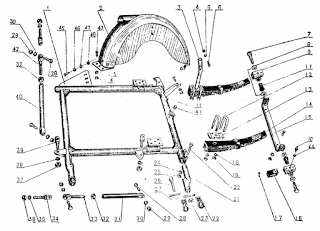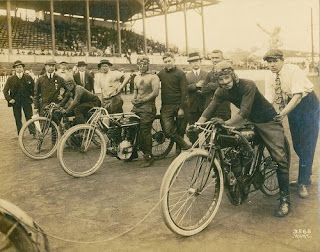If you want to have some fun with Early 20th Century motor camping, or just want to cruise around in classic style, one of the most exciting things you can put together is a motorcycle kit! Now, if you've ever priced an antique motorcycle, you've probably had heart palpitations and written it off as ridiculous, since no one wants to mortgage their house for the sake of a hobby!
1915 Harley Davidson Motorcycle - Priced to sell at "only" $110,000... Umm... Nope!
Fortunately, there are a reasonable handful of plans, kits, and even pre-built replicas available. You can build a decent bike for around $500-$1000 if you have some skills. You can usually find a well-built replica for around $2,000-$4,000. Obviously, the simpler the bike, the cheaper the build.For this reason, I'd recommend building an early bike. As motorcycles are easy to store under cover and were not used as primary family transportation, it was not unusual to see a 20-30 year old bike on the road. So, you can easily use a 19-oughts motorbike for a 1920's or 1930's impression. One of my close friends recently picked up a fairly well-made replica of a 1910 Harley Davidson for a reasonable price. It's built on a cruiser bicycle frame and looks good, though it has a chain drive instead of a belt drive.
The affordable replica my friend recently acquired. 1910 Harley-Davidson
So, my friend's acquisition was exciting and got me thinking about how to build a kit around a machine like this. First, there are a few adjustments the bike needs. First off, I think it would do well with a rear axle upgrade. The bicycle axle seems light for the abuse it needs to take from the motor drive chain. I think we'll but something heavier on it. Also, it needs a traveling toolkit, and some way to carry a little gear. For starters, we're going to put a small cargo rack on the back fender, however, long-term plan is to build a small sidecar to carry camp gear. That said, we'll have to come up with a very lightweight and simple kit to ride on the bike.
Don't take too much gear!! This will be too much weight for the motor, and might unbalance the bike. You won't use half of that junk anyway!
Do remember your toolkit!! A simple leather saddlebag or tube-case with a few basics such as pliers, screwdrivers, and a couple of spare chains and some inner tubes will keep you having fun!
Go for simple set-ups, and lightweight, practical kits. If you go out and find you don't use something you brought along, then kick it out of your kit!
Camp Setups:
Keep it simple... Really simple!
Go to your nearest farm supply store (Orscheln is great!) and buy a canvas grain tarp. Make sure you get one that is actual canvas. These are also oiled for waterproofing. You can use this to both cover your bike, and yourself, without any tentpoles! You'll want a couple of tent stakes, or you can cut wooden stakes at your campsite. Bring a firestarting kit, matches, or lighter and plan on cooking over a fire. Include a skillet, knife, cup, and spoon along with a canteen. (see my earlier blog post for details on how to cook an entire meal including coffee, in nothing more than a skillet!) You can pack a gunny sack and a blanket for sleeping. Fill the gunny sack with leaves or straw to make a pillow.
Oiled grain tarp used to cover bike and rider for the night.
Two bikes used to make a larger set-up. Remember that you don't need a giant coffee cup. You can refill a smaller one over and over and it won't take up as much space.
WWI-era pup tents are also lightweight and simple to set up. Two-part shelters can often be picked up from Civil War or WWI reenactment vendors for pretty cheap.
Clothing:
Early on, motorcycle clothing was about the same as that used for horseback riding. Some of this carried forward, even to today! ( Example: Jodhpurs, chaps, boots, etc) However, it didn't take long for bikers to realize that they needed a little more protection. Leather helmets and jackets were quick to come on the scene, as were goggles. Of course, leather helmets, such as those used by aviators in the period, weren't very strong. They would stop abrasions, but won't keep you from getting a skull fracture. Eventually, the racing industry developed better helmets for race car drivers and these made great motorcycle helmets as well. Of course, 100 years later, we now have far better techniques and materials for helmets, but they don't have the "look"... Or do they? Yes, Amazon has this repro helmet that fits the bill nicely! (and includes goggles!) For a jacket, you may have to scan eBay and Etsy or make one yourself. Butterick has re-released this vintage pattern. I recommend making the jacket in leather, and the jodhpurs in hemp duck with leather saddle, knee, and hip reinforcements. Tall riding boots are another hard thing to find. Watch eBay and Etsy for something appropriate. Don't pay more than $200 for a pair of boots. I've found them before as cheap as $65.
Original riding suit in the Harley-Davidson Museum
Tall boots and jodhpurs are standard among all bikers of the period!
Airman's soft leather helmet and goggles
MUCH safer, modern-built, period-looking replica available on Amazon for about $50.
Shorter motorcycle jacket.
Proper boots. These lace all the way up, but solid top boots, buckle straps, and half-lace boots are appropriate too.
While not very protective, branded sweaters seem to have been very popular in the period.
A great example of a branded sweater, helmet, goggles, tall boots, and jodhpurs with leather reinforcements. This would be a great, and fairly easy kit to replicate.
Of course, you can always dress any way you wish, but what I've outlined above seems to be the most common, the most practical, and the safest.
If you want to have some fun with your impression, consider portraying a police officer! Motorcycles were widely used by law enforcement and this can be a lot of fun at car shows!
Improving cargo space: (the sidecar)
I'm not going to go into a lot of detail here, because we're going to build one for my friend's bike. When we do that, there will probably be a full post about that. In the meantime though, here are some basic ideas...
Sidecars come in every possible shape and style. Some look like boats, or zeppelins, or aeroplanes. It's up to you as far as what it looks like.
Here are a few exploded images of a basic sidecar design.
I hope this has inspired a few folks! Have fun! Happy motoring! Get out there and do it!!
Here's a few great pictures that I didn't end up using, but need to be admired!






























